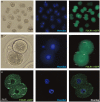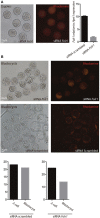Maternally Contributed Folate Receptor 1 Is Expressed in Ovarian Follicles and Contributes to Preimplantation Development
- PMID: 29034232
- PMCID: PMC5625018
- DOI: 10.3389/fcell.2017.00089
Maternally Contributed Folate Receptor 1 Is Expressed in Ovarian Follicles and Contributes to Preimplantation Development
Abstract
Folates have been shown to play a crucial role for proper development of the embryo as folate deficiency has been associated with reduced developmental capacity such as increased risk of fetal neural tube defects and spontanous abortion. Transcripts encoding the reduced folate carrier RFC1 (SLC19A1 protein) and the high-affinity folate receptor FOLR1 are expressed in oocytes and preimplantation embryos, respectively. In this study, we observed maternally contributed FOLR1 protein during mouse and human ovarian follicle development, and 2-cell mouse embryos. In mice, FOLR1 was highly enriched in oocytes from primary, secondary and tertiary follicles, and in the surrounding granulosa cells. Interestingly, during human follicle development, we noted a high and specific presence of FOLR1 in oocytes from primary and intermediate follicles, but not in the granulosa cells. The distribution of FOLR1 in follicles was noted as membrane-enriched but also seen in the cytoplasm in oocytes and granulosa cells. In 2-cell embryos, FOLR1-eGFP fusion protein was detected as cytoplasmic and membrane-associated dense structures, resembling the distribution pattern observed in ovarian follicle development. Knock-down of Folr1 mRNA function was accomplished by microinjection of short interference (si)RNA targeting Folr1, into mouse pronuclear zygotes. This revealed a reduced capacity of Folr1 siRNA-treated embryos to develop to blastocyst compared to the siRNA-scrambled control group, indicating that maternally contributed protein and zygotic transcripts sustain embryonic development combined. In summary, maternally contributed FOLR1 protein appears to maintain ovarian functions, and contribute to preimplantation development combined with embryonically synthesized FOLR1.
Keywords: blastocyst; folate receptor 1; follicle development; preimplantation development; siRNA.
Figures







Similar articles
-
Maternally contributed Nlrp9b expressed in human and mouse ovarian follicles contributes to early murine preimplantation development.J Assist Reprod Genet. 2020 Jun;37(6):1355-1365. doi: 10.1007/s10815-020-01767-w. Epub 2020 May 12. J Assist Reprod Genet. 2020. PMID: 32399794 Free PMC article.
-
Folate transport in mouse cumulus-oocyte complexes and preimplantation embryos.Biol Reprod. 2013 Sep 19;89(3):63. doi: 10.1095/biolreprod.113.111146. Print 2013 Sep. Biol Reprod. 2013. PMID: 23904512
-
Folate receptor-1 is vital for developmental competence of goat embryos.Reprod Domest Anim. 2022 May;57(5):541-549. doi: 10.1111/rda.14092. Epub 2022 Feb 16. Reprod Domest Anim. 2022. PMID: 35122705
-
Folate receptors and neural tube closure.Congenit Anom (Kyoto). 2017 Sep;57(5):130-133. doi: 10.1111/cga.12218. Epub 2017 Apr 18. Congenit Anom (Kyoto). 2017. PMID: 28244241 Review.
-
Importance of folate-homocysteine homeostasis during early embryonic development.Clin Chem Lab Med. 2007;45(12):1717-27. doi: 10.1515/CCLM.2007.345. Clin Chem Lab Med. 2007. PMID: 18067451 Review.
Cited by
-
One-Carbon Metabolism Regulates Embryonic Stem Cell Fate Through Epigenetic DNA and Histone Modifications: Implications for Transgenerational Metabolic Disorders in Adults.Front Cell Dev Biol. 2019 Nov 21;7:300. doi: 10.3389/fcell.2019.00300. eCollection 2019. Front Cell Dev Biol. 2019. PMID: 31824950 Free PMC article.
-
Neural tube defects: Sex ratio changes after fortification with folic acid.PLoS One. 2018 Mar 14;13(3):e0193127. doi: 10.1371/journal.pone.0193127. eCollection 2018. PLoS One. 2018. PMID: 29538416 Free PMC article. Clinical Trial.
-
Untargeted metabolomics reveals homogeneity and heterogeneity between physiological and pathological ovarian aging.J Ovarian Res. 2025 Mar 17;18(1):56. doi: 10.1186/s13048-025-01625-2. J Ovarian Res. 2025. PMID: 40098062 Free PMC article.
-
Enhanced branched-chain amino acid metabolism improves age-related reproduction in C. elegans.Nat Metab. 2024 Apr;6(4):724-740. doi: 10.1038/s42255-024-00996-y. Epub 2024 Feb 28. Nat Metab. 2024. PMID: 38418585
-
Folic acid supplementation on congenital heart disease and its dual character.Curr Res Pharmacol Drug Discov. 2025 May 9;8:100222. doi: 10.1016/j.crphar.2025.100222. eCollection 2025. Curr Res Pharmacol Drug Discov. 2025. PMID: 40487591 Free PMC article. Review.
References
LinkOut - more resources
Full Text Sources
Other Literature Sources
Molecular Biology Databases

